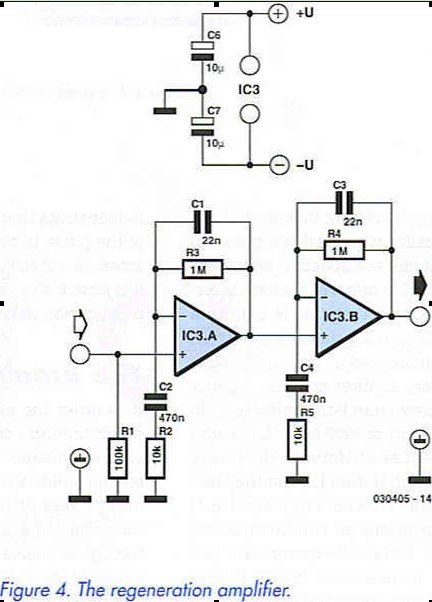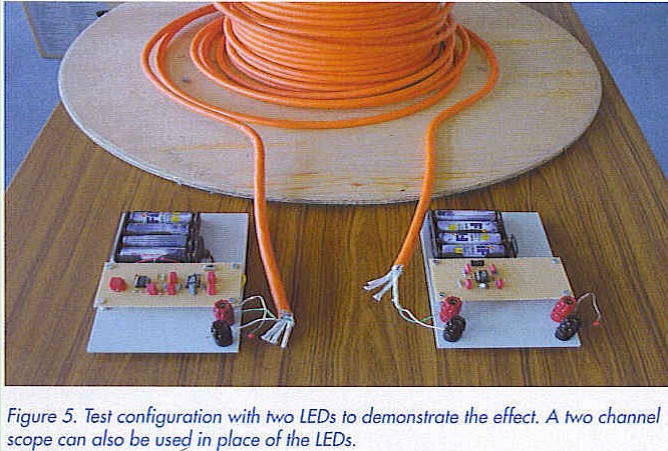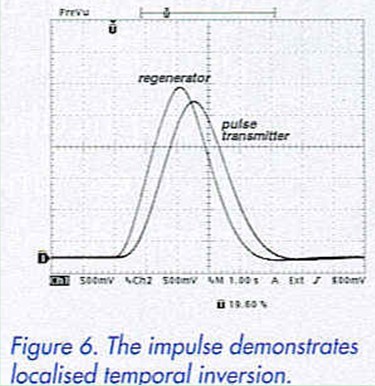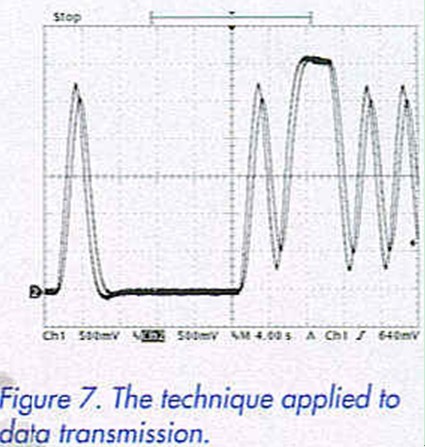

Project Solutions
Project C+ (2)
Published:2011/7/25 2:51:00 Author:Phyllis From:SeekIC
The medium
The choice of cable is vital in order to match the pulse profile to the characteristics of the transmission medium and thereby achieve the observed pulse acceleration. After much trial and error in the Elektor Electronics laboratory we concluded that a length of twisted-pair 100 Mbit/s Ethernet cable (CAT5) operated in the sub-hertz frequency range gave the most consistent results.
A cable length of 400 m was used in the prototype. In practice it is a good idea to cut it slightly longer so that it can be trimmed during testing to find its optimum length. The cable introduces a certain degree of attenuation to the low-frequency content of the pulse so the receiver circuit is pro-vided with some amplification to compensate. The receiver circuit diagram is shown in Figure 4 and uses a configuration similar to the transmitter. To operate reliably it is essential to ensure that the specified components are used throughout the circuit. The power supply can again either be single rail if you choose the OP290 op-amp or split-rail for the TL082. Once the receiver has been carefully completed and checked we can begin with the experiment. 
Back to reality
Figure 5 shows the test configuration for sending and measuring the highspeed pulses. With an oscilloscope connected to the transmitter output and another connected to the receiver output it can be clearly confirmed that when push button SI is pressed, the transmitted pulse arrives at the receiver before it is detected as having left the transmitter! Even if you do not have an oscilloscope the effect is so pronounced that it can be demonstrated by substituting two simple LEDs at the measuring points and observing the events that occur when SI is pressed. It is clearly observable that the receiver LED is lit slightly before the transmitter LED and then extinguishes before the transmitter LED! Figure 6 shows the pulse waveforms as seen on a scope. It may be necessary to adjust the length of the cable slightly if the effect is not observed. 

The revolution begins
The simple circuit described here replicates the findings of the original paper but only achieves a data rate of 0.5 b/s. To be truly useful this needs to be much faster, certainly in the region of Gb/s. To make the technology more practical a form of dynamically adaptive pulse shaping will also be necessary to compensate for the medium characteristics. Research into l-Ging is still in its infancy but these early results are so promising that we will undoubtedly see its adoption in more and more applications as the technology matures.
The principle of causality is a cornerstone of our interpretation of the physical world but the observed negative propagation delay of approximately 0.4 s through the transmission medium and receiver combination seems to conflict with our understanding of this principle and will no doubt set alarm bells ringing for many Elektor Electronics readers, theoreticians and scientists. In practice this technology would be used to send a stream of data at incredibly high speed rather than just a single pulse. The circuit was modified to send a pseudo random data sequence and the results are shown in Figure 7. The received signal shows very low levels of distortion and noise and more importantly still exhibits identical negative propagation delay through the medium. The circuit described here is quite simple and we feel that many sceptics amongst you will not be silenced until they have built the circuit for themselves and witnessed what must surely be a new dawn for communication science and computing. Can you explain the c+ phenomenon? If so, let us know as soon as you can so we can revert to the subject in next month’s issue.

Reprinted Url Of This Article: http://www.seekic.com/blog/project_solutions/2011/07/25/Project_C___(2).html
Print this Page | Comments | Reading(484)
Article Categories
New published articles
· Imagination works with TSMC to develop FinFET process
Author:Ecco Reading(45438)
· XMOS pushes event-driven MCUs with lower price
Author:Ecco Reading(4140)
· Intel brings upgraded 32-nm SoC for smartphones
Author:Ecco Reading(3863)
· Micron pushes TLC 128-Gbit NAND flash
Author:Ecco Reading(4611)
· Intel will stop supplying desktop motherboards
Author:Ecco Reading(5961)
· Processor market was expected to regain strength in 2013
Author:Ecco Reading(3956)
· It was reported that TSMC sales fall steeply
Author:Ecco Reading(3618)
· Cisco, NXP work with auto wireless startup
Author:Ecco Reading(4282)
· Micron was impacted by manufacturing glitch
Author:Ecco Reading(4647)
· China can make 22-nm transistor by themselves
Author:Ecco Reading(4485)
· Chip market rebound is coming, according to survey
Author:Ecco Reading(4386)
· Sony, Toshiba will spend more on chips, iSuppli reports
Author:Ecco Reading(3953)
· Qualcomm becomes the 13th company to join NFC Forum board
Author:Ecco Reading(6795)
· TSMC increases building work for FinFET fab
Author:Ecco Reading(4467)
· TI plans to cut 1,700 jobs in OMAP shift
Author:Ecco Reading(5327)